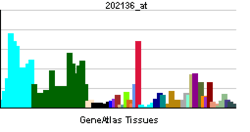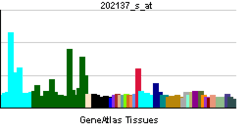ZMYND11
| View/Edit Human | View/Edit Mouse |
Zinc finger MYND domain-containing protein 11 is a protein that in humans is encoded by the ZMYND11 gene.[3][4][5]
Function
The protein encoded by this gene was first identified by its ability to bind the adenovirus E1A protein. The protein localizes to the nucleus. It functions as a transcriptional repressor, and expression of E1A inhibits this repression. Alternatively spliced transcript variants encoding different isoforms have been identified.[5]
Interactions
ZMYND11 has been shown to interact with:
References
- ↑ "Human PubMed Reference:".
- ↑ "Mouse PubMed Reference:".
- ↑ Hateboer G, Gennissen A, Ramos YF, Kerkhoven RM, Sonntag-Buck V, Stunnenberg HG, Bernards R (Jul 1995). "BS69, a novel adenovirus E1A-associated protein that inhibits E1A transactivation". The EMBO Journal. 14 (13): 3159–69. PMC 394377
 . PMID 7621829.
. PMID 7621829. - ↑ Masselink H, Bernards R (Mar 2000). "The adenovirus E1A binding protein BS69 is a corepressor of transcription through recruitment of N-CoR". Oncogene. 19 (12): 1538–46. doi:10.1038/sj.onc.1203421. PMID 10734313.
- 1 2 "Entrez Gene: ZMYND11 zinc finger, MYND domain containing 11".
- 1 2 Kurozumi K, Nishita M, Yamaguchi K, Fujita T, Ueno N, Shibuya H (Apr 1998). "BRAM1, a BMP receptor-associated molecule involved in BMP signalling". Genes to Cells. 3 (4): 257–64. doi:10.1046/j.1365-2443.1998.00186.x. PMID 9663660.
- ↑ Hughes-Davies L, Huntsman D, Ruas M, Fuks F, Bye J, Chin SF, Milner J, Brown LA, Hsu F, Gilks B, Nielsen T, Schulzer M, Chia S, Ragaz J, Cahn A, Linger L, Ozdag H, Cattaneo E, Jordanova ES, Schuuring E, Yu DS, Venkitaraman A, Ponder B, Doherty A, Aparicio S, Bentley D, Theillet C, Ponting CP, Caldas C, Kouzarides T (Nov 2003). "EMSY links the BRCA2 pathway to sporadic breast and ovarian cancer". Cell. 115 (5): 523–35. doi:10.1016/s0092-8674(03)00930-9. PMID 14651845.
- ↑ Wei G, Schaffner AE, Baker KM, Mansky KC, Ostrowski MC. "Ets-2 interacts with co-repressor BS69 to repress target gene expression". Anticancer Research. 23 (3A): 2173–8. PMID 12894593.
Further reading
- Bonaldo MF, Lennon G, Soares MB (Sep 1996). "Normalization and subtraction: two approaches to facilitate gene discovery". Genome Research. 6 (9): 791–806. doi:10.1101/gr.6.9.791. PMID 8889548.
- Kurozumi K, Nishita M, Yamaguchi K, Fujita T, Ueno N, Shibuya H (Apr 1998). "BRAM1, a BMP receptor-associated molecule involved in BMP signalling". Genes to Cells. 3 (4): 257–64. doi:10.1046/j.1365-2443.1998.00186.x. PMID 9663660.
- Lo KW, Naisbitt S, Fan JS, Sheng M, Zhang M (Apr 2001). "The 8-kDa dynein light chain binds to its targets via a conserved (K/R)XTQT motif". The Journal of Biological Chemistry. 276 (17): 14059–66. doi:10.1074/jbc.M010320200. PMID 11148209.
- Ansieau S, Leutz A (Feb 2002). "The conserved Mynd domain of BS69 binds cellular and oncoviral proteins through a common PXLXP motif". The Journal of Biological Chemistry. 277 (7): 4906–10. doi:10.1074/jbc.M110078200. PMID 11733528.
- Wei G, Schaffner AE, Baker KM, Mansky KC, Ostrowski MC (2003). "Ets-2 interacts with co-repressor BS69 to repress target gene expression". Anticancer Research. 23 (3A): 2173–8. PMID 12894593.
- Hughes-Davies L, Huntsman D, Ruas M, Fuks F, Bye J, Chin SF, Milner J, Brown LA, Hsu F, Gilks B, Nielsen T, Schulzer M, Chia S, Ragaz J, Cahn A, Linger L, Ozdag H, Cattaneo E, Jordanova ES, Schuuring E, Yu DS, Venkitaraman A, Ponder B, Doherty A, Aparicio S, Bentley D, Theillet C, Ponting CP, Caldas C, Kouzarides T (Nov 2003). "EMSY links the BRCA2 pathway to sporadic breast and ovarian cancer". Cell. 115 (5): 523–35. doi:10.1016/S0092-8674(03)00930-9. PMID 14651845.
- Colland F, Jacq X, Trouplin V, Mougin C, Groizeleau C, Hamburger A, Meil A, Wojcik J, Legrain P, Gauthier JM (Jul 2004). "Functional proteomics mapping of a human signaling pathway". Genome Research. 14 (7): 1324–32. doi:10.1101/gr.2334104. PMC 442148
 . PMID 15231748.
. PMID 15231748. - Rual JF, Venkatesan K, Hao T, Hirozane-Kishikawa T, Dricot A, Li N, Berriz GF, Gibbons FD, Dreze M, Ayivi-Guedehoussou N, Klitgord N, Simon C, Boxem M, Milstein S, Rosenberg J, Goldberg DS, Zhang LV, Wong SL, Franklin G, Li S, Albala JS, Lim J, Fraughton C, Llamosas E, Cevik S, Bex C, Lamesch P, Sikorski RS, Vandenhaute J, Zoghbi HY, Smolyar A, Bosak S, Sequerra R, Doucette-Stamm L, Cusick ME, Hill DE, Roth FP, Vidal M (Oct 2005). "Towards a proteome-scale map of the human protein-protein interaction network". Nature. 437 (7062): 1173–8. doi:10.1038/nature04209. PMID 16189514.
- Isobe T, Uchida C, Hattori T, Kitagawa K, Oda T, Kitagawa M (Jan 2006). "Ubiquitin-dependent degradation of adenovirus E1A protein is inhibited by BS69". Biochemical and Biophysical Research Communications. 339 (1): 367–74. doi:10.1016/j.bbrc.2005.11.028. PMID 16300738.
- Wan J, Zhang W, Wu L, Bai T, Zhang M, Lo KW, Chui YL, Cui Y, Tao Q, Yamamoto M, Akira S, Wu Z (Jan 2006). "BS69, a specific adaptor in the latent membrane protein 1-mediated c-Jun N-terminal kinase pathway". Molecular and Cellular Biology. 26 (2): 448–56. doi:10.1128/MCB.26.2.448-456.2006. PMC 1346911
 . PMID 16382137.
. PMID 16382137. - Velasco G, Grkovic S, Ansieau S (Jun 2006). "New insights into BS69 functions". The Journal of Biological Chemistry. 281 (24): 16546–50. doi:10.1074/jbc.M600573200. PMID 16565076.
This article is issued from Wikipedia - version of the 5/20/2016. The text is available under the Creative Commons Attribution/Share Alike but additional terms may apply for the media files.

